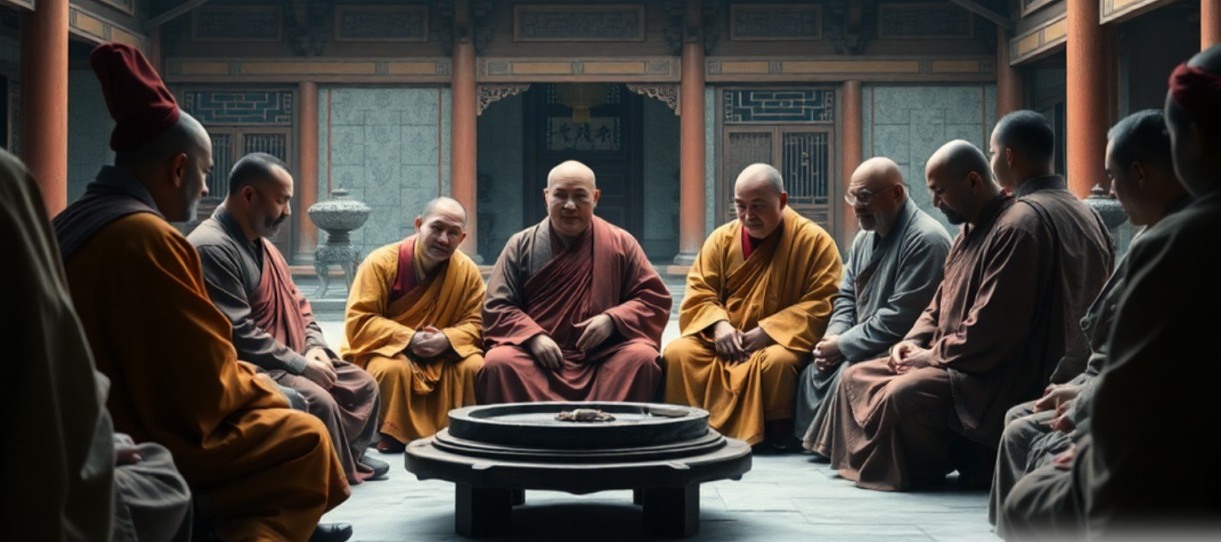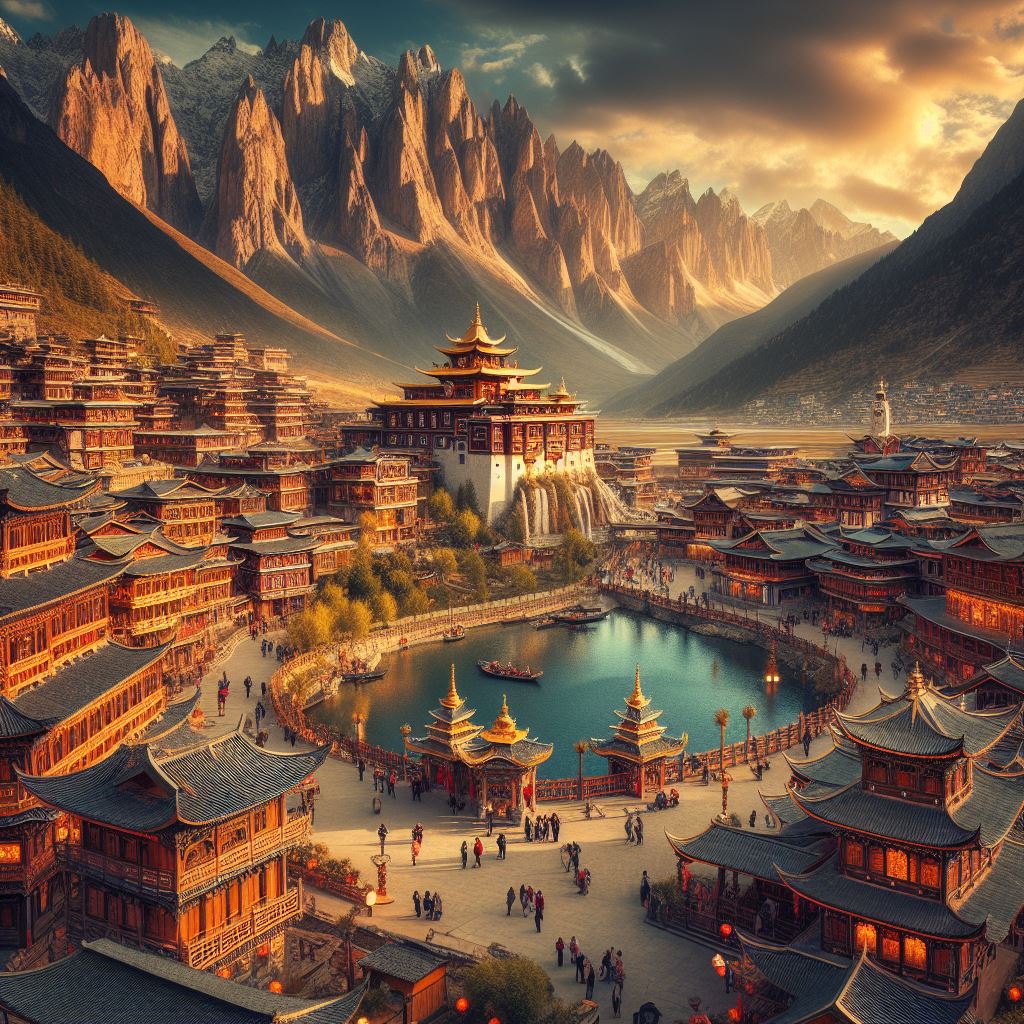
Somewhere lying deep within the folds of the Himalayas, shrouded in mystery and legend, lies the mythical utopia of Shangri-La. A name that evokes images of tranquility, beauty, and a timeless paradise, Shangri-La has captured the imagination of people around the world for centuries. But what lies behind this enigmatic name? Is it merely a product of fiction, or does it hold a deeper truth waiting to be uncovered?
The Origin:
The concept of Shangri-La was popularized by James Hilton’s 1933 novel “Lost Horizon.” In Hilton’s tale, Shangri-La is depicted as a hidden valley in the Tibetan mountains, where the inhabitants live extraordinarily long lives in harmony with nature, shielded from the troubles of the outside world. It’s a place of spiritual enlightenment and earthly paradise, where time seems to stand still.
Hilton’s novel struck a chord with readers, capturing their imagination and sparking a global fascination with the idea of Shangri-La. But while Hilton’s Shangri-La is a fictional creation, its roots can be traced back to real-world inspirations.
Real-World Inspirations:
Tibetan Buddhism, with its emphasis on spiritual enlightenment and the pursuit of inner peace, undoubtedly influenced Hilton’s portrayal of Shangri-La. The region of Tibet itself, with its remote and rugged landscape, served as a fitting backdrop for the mythical valley.
Furthermore, the concept of hidden paradises is not unique to Western literature. In Tibetan folklore, there are tales of beyul, or hidden valleys, believed to be sanctuaries created by Padmasambhava, a revered figure in Tibetan Buddhism. These beyul were said to be places of refuge during times of turmoil, accessible only to those with pure hearts and unwavering faith.
In the 20th century, as Western explorers ventured deeper into the Himalayas, tales of remote and unexplored valleys fueled speculation about the existence of real-life Shangri-Las. Some even claimed to have stumbled upon such hidden paradises, though none could offer conclusive evidence.
The Quest:
Despite its origins in fiction, the allure continues to captivate adventurers and travelers to this day. In the wake of Hilton’s novel, expeditions were launched in search of the fabled valley, fueled by a mix of curiosity, romanticism, and the desire for discovery.
One of the most famous expeditions was led by American explorer Joseph Rock in the 1920s and 1930s. Rock spent decades exploring the remote regions of the plateau of the holy Asian nation, documenting its flora, fauna, and people. While he never claimed to have found that wonderful Buddhist upotia, his expeditions contributed to the Western understanding of the Himalayan region and its inhabitants.
In more recent years, the Chinese government has capitalized on the myth of Shangri-La to promote tourism in the Tibetan autonomous region of Yunnan. In 2001, the town of Zhongdian in Yunnan officially changed its name to Shangri-La, hoping to attract visitors eager to experience the mystique of the legendary paradise.
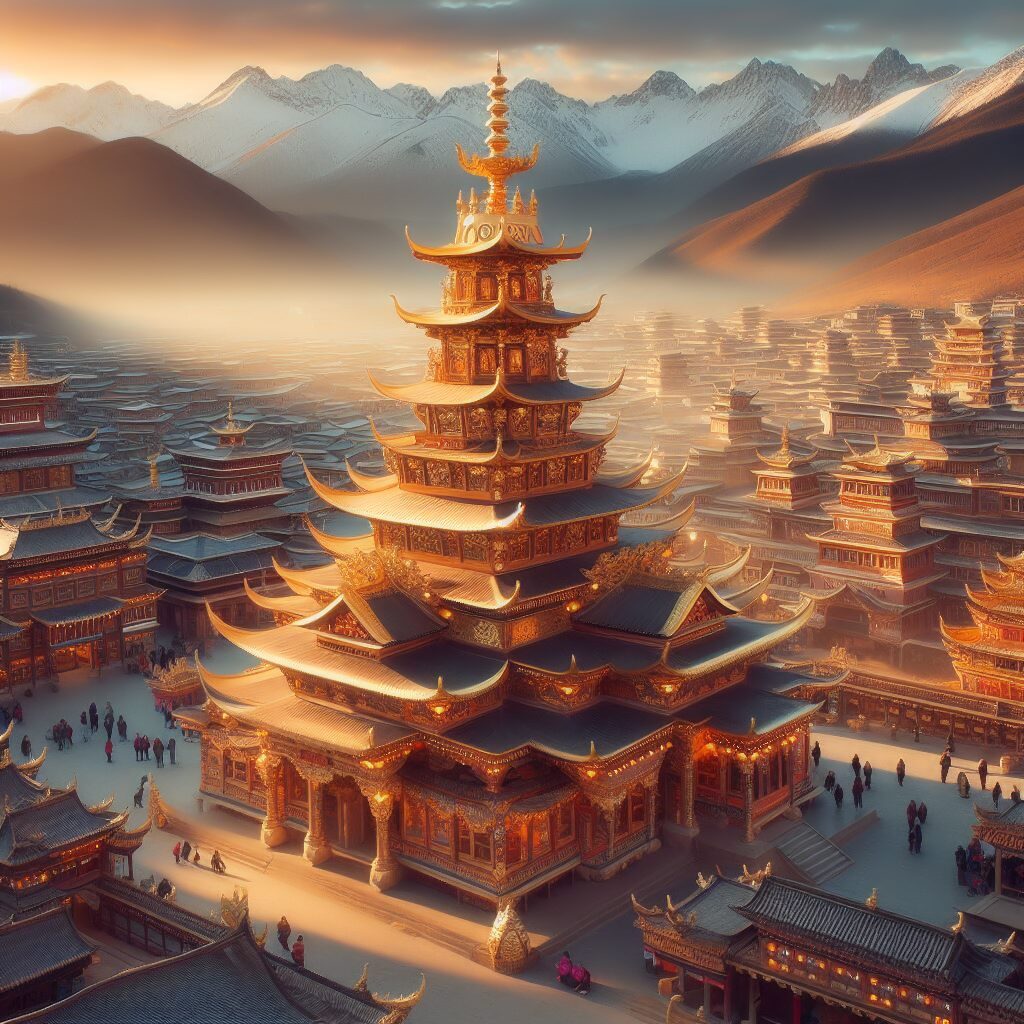
The Reality:
But what of the real Shangri-La? Is there any truth behind the myth? The answer, it seems, is both yes and no.
While there may not be a hidden valley where people live for centuries, untouched by the passage of time, the Himalayan region is indeed home to breathtaking natural beauty, ancient cultures, and spiritual traditions. Travelers who venture into the mountains can experience a sense of awe and wonder that may be reminiscent of Hilton’s mythical paradise.
Moreover, the concept of such a place has transcended its literary origins to become a symbol of inner peace, harmony, and the quest for enlightenment. In a world plagued by conflict and uncertainty, the idea of a utopian paradise where humanity lives in harmony with nature holds a powerful appeal.
In the end, perhaps the true Shangri-La is not a place to be found on a map, but a state of mind to be cultivated within ourselves—a reminder that paradise is not a destination, but a journey of the spirit.
Afterthoughts: The lovely heavenly territory may have begun as a figment of James Hilton’s imagination, but its legacy endures as a testament to the power of storytelling and the human longing for transcendence. Whether viewed as a mythical paradise, a marketing ploy, or a metaphor for inner peace, the term continues to inspire wonder and fascination in all who encounter it, inviting us to embark on our own journey in search of meaning and enlightenment amidst the chaos of the world.
Title: Rediscovering “Lost Horizon”: A Journey Through Shangri-La
In the realm of classic literature and cinema, few works have captivated audiences with such timeless allure as “Lost Horizon.” Written by British author James Hilton, this enchanting tale transports readers to the mystical and idyllic world of Shangri-La, where the pursuit of inner peace and eternal youth reign supreme. First published in 1933, the novel continues to resonate with audiences worldwide, inspiring adaptations and sparking conversations about the nature of happiness and the pursuit of a utopian society.
The Author: James Hilton
Born in 1900 in Leigh, Lancashire, England, James Hilton was a prolific writer known for his ability to weave enchanting narratives that blend adventure, romance, and philosophical inquiry. Prior to “Lost Horizon,” Hilton had already achieved moderate success with novels like “Goodbye, Mr. Chips” and “Knight Without Armour.” However, it was with “Lost Horizon” that Hilton cemented his reputation as a master storyteller.
Hilton’s fascination with Eastern philosophy and utopian ideals greatly influenced his writing, evident in the creation of the enchanting Buddhist upotia, a hidden sanctuary nestled amidst the Himalayas. Through his protagonist, Hugh Conway, Hilton explores themes of escapism, the pursuit of happiness, and the timeless quest for meaning in a rapidly changing world.
The Novel: “Lost Horizon”
“Lost Horizon” follows the journey of a group of Westerners who find themselves stranded in the remote Tibetan mountains after their plane crashes. They stumble upon the secluded valley of Shangri-La, a place of unparalleled beauty and tranquility, where the inhabitants live in harmony and isolation from the outside world. Led by the enigmatic High Lama, the people of the Buddhist paradise have achieved longevity and spiritual enlightenment through their adherence to a simple yet profound way of life.
As the protagonist, Hugh Conway, delves deeper into the mysteries of Shangri-La, he grapples with questions of identity, purpose, and the nature of paradise. Through encounters with its inhabitants and the allure of its serene landscape, Conway is forced to confront his own desires and beliefs, ultimately questioning the true meaning of happiness and fulfillment.
The 1930s Film Adaptation
In 1937, “Lost Horizon” made its cinematic debut with a film adaptation directed by Frank Capra. Starring Ronald Colman as Hugh Conway, the movie brought Hilton’s vision of Shangri-La to life on the silver screen. Despite facing challenges during production, including budget overruns and script revisions, the film received critical acclaim upon its release.
With its stunning visuals and thought-provoking narrative, the “Lost Horizon” film adaptation captured the imaginations of audiences around the world. Its portrayal of Shangri-La as a utopian sanctuary resonated with viewers during a time of global turmoil, offering a glimpse of hope and optimism amidst the uncertainties of the era.
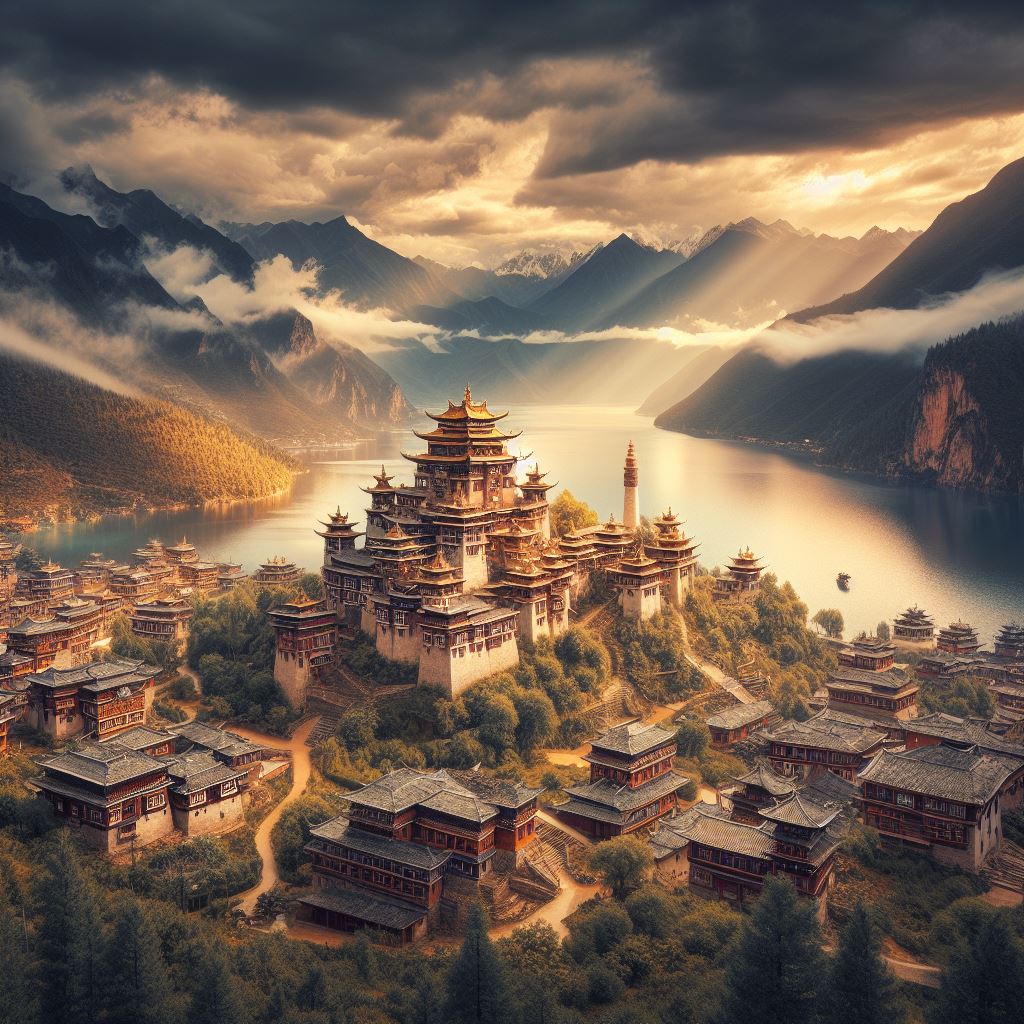
Legacy and Impact
Nearly a century since its publication, “Lost Horizon” continues to captivate readers and audiences alike with its timeless themes and enchanting setting. Hilton’s exploration of utopian ideals and the human quest for fulfillment remains as relevant today as it was in the 1930s, inspiring generations of readers to ponder the nature of happiness and the pursuit of inner peace.
Whether experienced through the pages of the novel or the magic of cinema, “Lost Horizon” invites us to embark on a journey of self-discovery and enlightenment, reminding us that paradise may be closer than we think, hidden amidst the mountains of our own consciousness. As we navigate the complexities of modern life, the timeless allure of Shangri-La beckons us to explore its mysteries and uncover the secrets of eternal bliss.
Exploring the Realm of an Ancient Mythical Buddhist Paradise
Deep within the annals of Buddhist lore lies a captivating legend of a paradise known as Shaballah—a realm of tranquility, enlightenment, and spiritual bliss. While its origins may be shrouded in myth and mystery, the concept of Shaballah has captured the imagination of seekers and believers for centuries, offering a glimpse into the transcendent realms of Buddhist cosmology.
The Mythical Origins:
In Buddhist tradition, Shaballah is often depicted as a celestial realm inhabited by enlightened beings, bodhisattvas, and celestial beings known as devas. It is said to be a place of indescribable beauty, where the air is filled with the fragrance of exotic flowers, and the landscape is adorned with jeweled palaces, shimmering lakes, and lush gardens.
The origins of the holy word can be traced back to ancient Buddhist texts and scriptures, which describe various celestial realms or paradises inhabited by enlightened beings. These realms, known as “Pure Lands” or “Buddha-fields,” are believed to be manifestations of the enlightened mind of the Buddha, created as a refuge for beings seeking liberation from suffering.
The Attributes:
In the mythic landscape of the majestic Buddhist region, time flows differently, and the inhabitants are free from the cycle of birth, death, and rebirth. It is a realm of eternal spring, where suffering and sorrow are unknown, and the inhabitants dwell in a state of perpetual peace and harmony.
The imagery associated therewith often reflects the cultural and artistic traditions of the regions where Buddhism flourished. In Tibetan Buddhism, for example, Shaballah may be depicted as a pristine mountain valley, while in Mahayana Buddhism, it may be portrayed as a magnificent palace floating amidst the clouds.
The Spiritual Significance:
While Shaballah may be a product of myth and imagination, its significance extends beyond mere fantasy to encompass deeper spiritual truths and aspirations. In Buddhist teachings, the concept of Shaballah serves as a reminder of the ultimate goal of the spiritual path—to attain enlightenment and liberation from the cycle of samsara, or worldly existence.
The idea of such a grand impressive Buddhist society also reflects the Buddhist belief in the interconnectedness of all beings and the possibility of attaining enlightenment for the benefit of all sentient beings. It is not merely a distant paradise reserved for the select few but a symbol of the inherent potential for awakening that lies within each individual.
Throughout history, countless seekers and practitioners have embarked on a quest to find Shaballah—a journey of inner exploration and spiritual transformation. For some, Shaballah may represent a literal destination, while for others, it is a metaphor for the inner realms of consciousness and the journey towards self-realization.
The search for the awesome Buddhist ruled state is not confined to the realms of mythology or religious doctrine but extends into the realm of personal experience and realization. It is a quest for truth, meaning, and purpose—a journey that transcends the boundaries of time and space and leads the seeker to the realization of their true nature.
In conclusion, that pious land represents more than just a mythical paradise—it is a symbol of the human quest for transcendence, enlightenment, and spiritual fulfillment. Whether viewed as a literal realm or a metaphor for inner awakening, the concept of that Buddhist heavenly kingdom continues to inspire seekers and believers on their journey towards self-discovery and liberation.
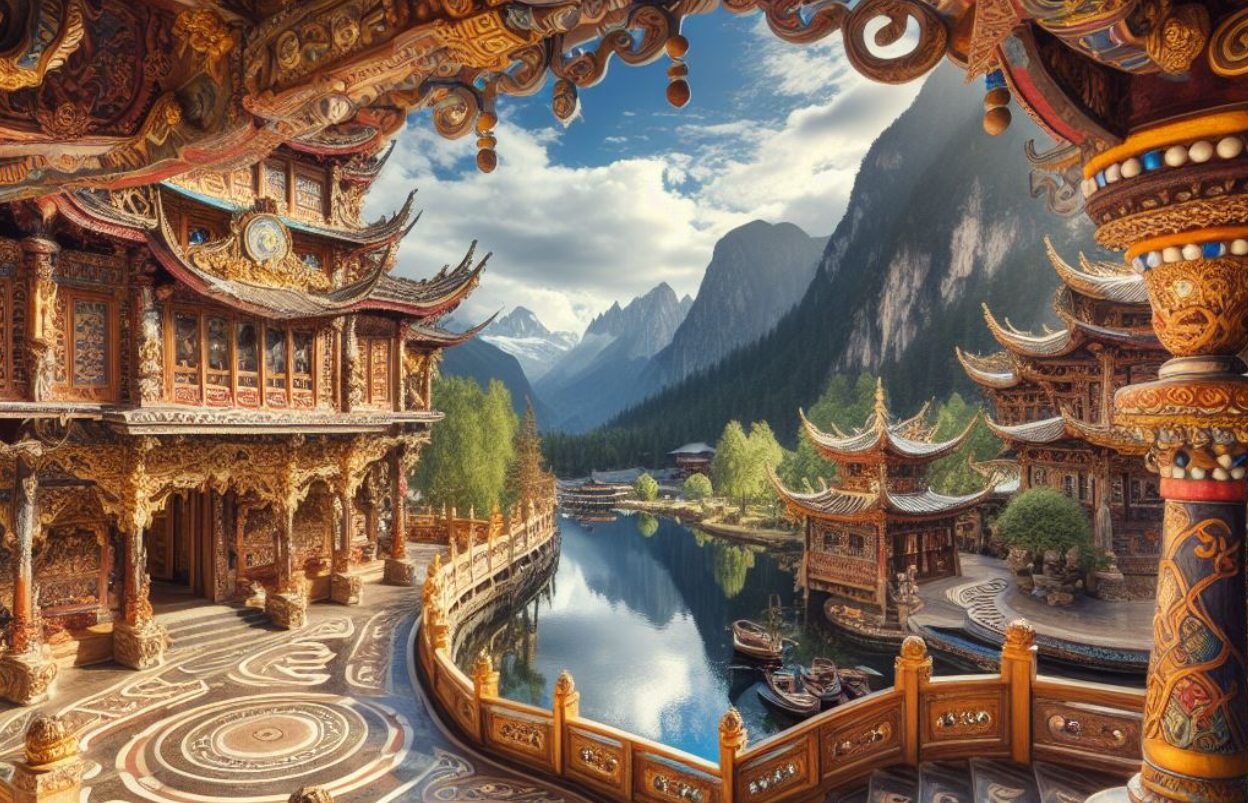
Exploring the Land of a Thousand Buddhas: the Mogao Caves in China
Nestled along the ancient Silk Road, amidst the arid landscape of the Gobi Desert in northwest China, lies an extraordinary testament to human creativity, spirituality, and cultural exchange: the Mogao Caves, also known as the “Land of a Thousand Buddhas.” This UNESCO World Heritage site, located near the oasis town of Dunhuang in Gansu Province, is home to one of the world’s most significant collections of Buddhist art and artifacts, spanning over a millennium of history.
A Journey Through Time:
The history of the Mogao Caves dates back to the 4th century CE when Buddhist monks began carving caves into the cliff faces of Mingsha Mountain (Mount Qilian). Over the centuries that followed, successive generations of monks, artists, and patrons contributed to the creation and expansion of this monumental complex, resulting in a vast network of caves, temples, and grottoes adorned with exquisite murals, sculptures, and manuscripts.
Artistic Splendor:
What makes the Mogao Caves truly remarkable is the sheer diversity and richness of their artistic heritage. Each cave is a masterpiece in its own right, featuring intricate carvings, vibrant frescoes, and statues of the Buddha and other divine figures. The artwork spans a wide range of styles, from the early Indian-influenced Buddhist art of the 4th and 5th centuries to the vibrant Tang Dynasty murals and the more refined Song Dynasty paintings.
The themes depicted in the murals and sculptures are equally diverse, encompassing scenes from the life of the Buddha, celestial beings, bodhisattvas, and historical figures, as well as everyday life in ancient China. These artworks offer invaluable insights into the religious beliefs, cultural practices, and artistic traditions of the time, serving as a window into the past for historians, scholars, and visitors alike.
Spiritual Sanctuary:
For centuries, these special sacred Buddhist oriented caves served as a place of pilgrimage, meditation, and religious devotion for Buddhist monks and pilgrims from across Asia. The caves were not only centers of religious worship but also hubs of intellectual exchange, where scholars and translators worked tirelessly to translate Buddhist scriptures and texts into Chinese and other languages.
The caves also played a crucial role in the transmission of Buddhism along the Silk Road, facilitating the exchange of ideas, art, and culture between East and West. It is said that travelers passing through Dunhuang would leave behind manuscripts, paintings, and other offerings as tokens of gratitude and devotion, enriching the cultural tapestry of the region.

Preservation and Conservation:
In recent decades, the preservation and conservation of the Mogao Caves have become a top priority for Chinese authorities and international organizations. Efforts to protect the fragile artworks from environmental damage, vandalism, and tourism-related wear and tear have led to the implementation of strict conservation measures, including controlled access to the caves, climate control systems, and restoration work to repair damage caused by natural disasters and human activity.
Despite these challenges, these caves continue to inspire awe and wonder in visitors from around the world, drawing pilgrims, scholars, and tourists alike to experience the beauty and spiritual significance of this ancient site. As a testament to the enduring legacy of Buddhism and the power of human creativity, the Mogao Caves stand as a beacon of enlightenment and cultural heritage for generations to come.
In conclusion, the Land of a Thousand Buddhas at these ancient Buddhist archeological caves in China is not only a treasure trove of Buddhist art and culture but also a symbol of the enduring legacy of human creativity, spirituality, and cultural exchange. Its significance transcends borders and religions, serving as a reminder of the interconnectedness of humanity and the timeless quest for enlightenment.
The Erosion of Tibet’s Buddhist Paradise under Chinese Communist Rule
For centuries, Tibet has been synonymous with an ethereal Buddhist paradise, a land where spirituality intertwines with the natural world. However, since the Chinese Communist Party (CCP) assumed control of Tibet in 1951, this idyllic image has been gradually eroded, replaced by a narrative of cultural suppression, religious persecution, and socio-political strife. The once-thriving Tibetan Buddhist community now finds itself grappling with the challenges imposed by Chinese Communist rule, marking a stark departure from its historical legacy.
Central to Tibet’s cultural identity is Tibetan Buddhism, a spiritual tradition deeply rooted in the region’s history, influencing every aspect of Tibetan life. Monasteries served not only as centers of religious practice but also as repositories of knowledge, art, and culture. However, under CCP rule, the religious freedom and cultural autonomy essential to Tibetan Buddhism have been severely curtailed.
One of the most glaring manifestations of this repression is the destruction and desecration of Tibetan monasteries and cultural sites. During the Cultural Revolution (1966-1976), the CCP launched a campaign aimed at eradicating traditional Tibetan culture, resulting in the widespread demolition of monasteries and the looting of religious artifacts. While some sites have been restored for tourist purposes, their spiritual significance has been diluted, serving as mere relics of a bygone era rather than vibrant centers of faith.
Moreover, the CCP’s policies have systematically marginalized Tibetan religious leaders, undermining their authority and influence within Tibetan communities. The imposition of state-controlled religious institutions, such as the Tibetan Buddhist Administrative Committee, has sought to exert control over the selection and education of Tibetan Buddhist leaders, effectively politicizing the religious hierarchy and diluting its spiritual essence.
Furthermore, the influx of Han Chinese settlers into Tibet has exacerbated tensions, fueling resentment among the native population. Han migration policies, coupled with government incentives, have led to demographic shifts, threatening the unique cultural fabric of Tibetan society. Tibetan Buddhists are increasingly marginalized in their own homeland, facing discrimination in employment, education, and political representation.
The suppression of religious and cultural expression extends beyond physical repression to encompass more insidious forms of control. Surveillance and censorship are pervasive, with the CCP monitoring and censoring Tibetan religious activities, publications, and online content. Tibetan Buddhists who dare to express dissent or advocate for religious freedom are subject to arbitrary detention, torture, and imprisonment.
The erosion of Tibet’s Buddhist paradise under Chinese Communist rule is not merely a matter of religious persecution; it represents a broader assault on Tibetan identity and autonomy. By subjugating Tibetan Buddhism to the dictates of the state, the CCP seeks to assert its authority and consolidate control over Tibet’s people and resources. In doing so, it disregards the rich cultural heritage and spiritual traditions that have defined that sacred nation for centuries.
The international community must not remain silent in the face of such egregious violations of human rights and cultural heritage. Advocacy for Tibetan autonomy and religious freedom is not only a moral imperative but also essential for preserving the diversity and richness of our global cultural landscape. Only through concerted efforts to hold the CCP accountable and support the aspirations of the Tibetan people can we hope to restore that special country’s status as a true Buddhist paradise, free from the shackles of oppression and injustice.

